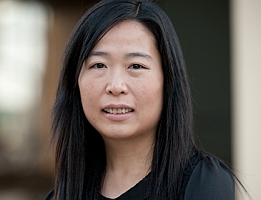20 May 2014. Engineers and medical researchers at Stanford University in California designed a wireless system that can transfer electric power deep inside the body for miniaturized implants and other therapies. The work of a team led by electrical engineering professor Ada Poon was published online yesterday in Proceedings of the National Academy of Sciences (paid subscription required).
Poon and colleagues are seeking improvements in the design of electronic medical implants, such as deep-brain stimulators and heart pacemakers that now require a long-term power source like a battery built into the device or hard-wired from outside the body. These power sources add bulk, weight, and complexity to the devices, as well as requiring in some cases surgery to replace the device once the battery runs out.
The system invented by the Stanford team transfers electric power from a power source about the size of a credit card held above the device outside the body to a tiny power harvester and battery coupled to the device. This technique makes it possible to reduce the size of a heart pacemaker, for example, to about the size of a grain of rice.
The researchers achieved this breakthrough by combining the properties of far-field and near-field electromagnetic waves that behave differently when they come into contact with water and biological matter. Far-field waves can travel over long distances, but are reflected off skin and other tissue, or converted to heat. Near-field electromagnetic waves, like those used to recharge electric toothbrushes and power some current medical devices, can penetrate through tissue but only travel over very short distances.
Poon and colleagues succeeded in finding the precise balance between far- and near-field waves that captures the ability to penetrate through tissue over sufficient distances to power implanted devices. They call this optimum point between the two frequencies mid-field wireless transfer.
The team tested mid-field wireless transfer in animals, including a heart pacemaker 2 millimeters (0.08 inches) long implanted in a rabbit. Poon’s lab is now preparing the system for tests with humans, which requires further development of the technology and regulatory approvals.
In addition to powering smaller versions of current implants, Poon believes the mid-field wireless transfer can be applied to a wider range of therapies that stimulate electrical signaling mechanisms in the body. New types of implants, she notes, could offer safer pain relief than some current medications or stimulate brain circuits to treat Parkinson’s disease and other neurological disorders.
The Stanford researchers tell more about their invention in the following video.
- Study Aims to Boost Wireless Channel Management, Performance
- Early Trial Shows Wireless Pacemaker Safe, Effective
- Techniques Boost Range, Accuracy of Wireless ID Signals
- Wireless Brain Sensor Designed, Tested in Animals
- Feasibility Demonstrated of Tiny Wireless Cardiac Implants
* * *


 RSS - Posts
RSS - Posts
You must be logged in to post a comment.